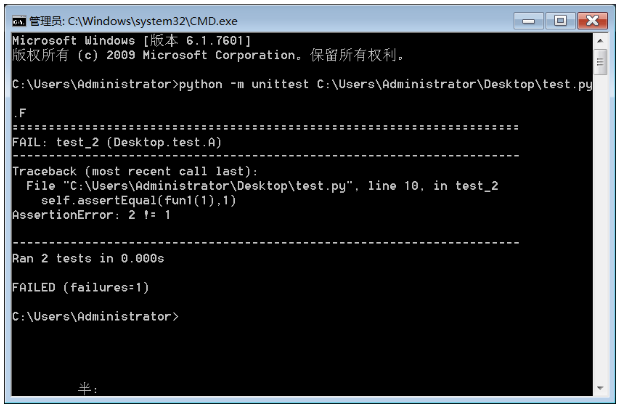Generate documents with pydoc
Classification and order of document information
- Documentation of the module
- CLASSES: lists all CLASSES contained in the module
- FUNCTIONS: lists all FUNCTIONS contained in the module
- DATA: lists all class member variables contained in the module
- FILE: the source FILE corresponding to the module
Operating in the console
python -m pydoc Module name #To view the help document, press the spacebar to open the next page python -m pydoc -w Module name #Help documents generate HTML files python -m pydoc -w Directory name #HTML files are generated from the help documents of all modules in the directory python -m pydoc -p Port number #View document information in the local server (browser) python -m pydoc -k Module name #Find module
- When generating help documents by directory, the description documents of sub files should be found manually and cannot be displayed directly
Software Testing Overview
Concept: use manual and automatic means to run and test the whole system, check whether it meets the requirements, or clarify the difference between the expected results and the actual results.
Objective: to systematically find out the errors and defects in the software with the least time and manpower
Common tools: Bugzilla, BugFree, MantisBT
principle
- Test early
- Planned testing. Write test plans and prepare test cases before testing
- Comprehensive. All possible results are executed at least once. Each statement is executed at least once
- Save test results
classification
It is usually divided into unit test and comprehensive test. It can also be divided into static test and dynamic test.
- Code review. Consistency, standardization, readability and structural rationality of code
- Code analysis. Process analysis, interface analysis and expression analysis of the program
- Document check.
- Defects are found through operation and exploration
#Document test
The functions and expected results to be tested are written in annotations, and then called doctest.. Testmod(), if all tests pass, the run result is empty. Otherwise, all error lines and functions will be displayed.
'''
>>> test() #Function to run
2
'''
def test(): #Function to be tested
return 1
import doctest
doctest.testmod()
**********************************************************************
File "C:\Users\Administrator\Desktop\test.py", line 2, in __main__
Failed example:
test() #Function to run
Expected:
2
Got:
1
**********************************************************************
1 items had failures:
1 of 1 in __main__
***Test Failed*** 1 failures.
PyUnit(unitest)
usage
Used to write and run repeatable tests
The test class needs to inherit unittest Testcase, and its method meets the following requirements:
- no return value
- No parameters
- Start with [test_]
import unitest
from To be tested.py import *
class TestModule(unittest.TestCase):
def test_1(self):
self.assertEqual(Function 1 (parameter), result)
def test_2(self):
self.assertEqual(Function 2 (parameter), result)
unittest. Assertion method in testcase
Most commonly used
| Method - yes | Method - negative | parameter |
|---|---|---|
| assertIsNone() | assertIsNotNone() | x |
| assertTrue() | assertFlase() | |
| assertEqual() | assertNotEqual() | a, b |
| assertIs() | assertIsNot() | |
| assertIn() | assertNotIn() | |
| assertInstance() | assertNotInstance() |
For specific inspection
| method | parameter | Inspection conditions |
|---|---|---|
| assertGreater() | a, b | a > b |
| assertLess() | a < b | |
| assertGreaterEqual() | a >= b | |
| assertLessEqual() | a <= b | |
| assertCountEqual() | Two sequence elements are the same - ignore order | |
| assertRegex() | s, r | r.search(s) |
| assertNotRegex() | not r.search(s) |
Exception, error, warning, log
| method | parameter | Inspection conditions |
|---|---|---|
| assertRaise() | exc, fun, *args, **kwds | fun() threw exc exception |
| assertRaiseRegex() | exc, r, fun, *args, **kwds | fun() throws an exc exception, And the exception information matches the r regular expression |
| assertWarns() | warn, fun, *args, **kwds | fun() raises a warn |
| assertWarnsRegex() | warn, r, fun, *args, **kwds | fun() raises a warn, And the warning information matches the r regular expression |
| assertLogs() | logger, level | The With statement block uses a logger, Generate level logs |
- *args, **kwds is the location parameter and keyword parameter of fun
Run test
In the test code, enter: unittest main()
Enter: python -m unittest test test file in CMD
Run all test cases in the directory: py -m unittest
In the test results, each character represents a test case (a method starting with test)
| character | [.] | F - Failure | E - error | s - skip | OK |
|---|---|---|---|---|---|
| meaning | Test passed | fail | error | skip | All tests passed |
Run results in python
Note: be sure to use class. If you use def, the program will be interrupted when the first error is encountered
import unittest
def fun1(x): return x+1
def fun2(y): return x+2
class A(unittest.TestCase):
def test_1(self):
self.assertEqual(fun1(1),2)
def test_2(self):
self.assertEqual(fun1(1),1)
unittest.main() #Run the program (this line is not required when running under CMD)
Operation results
.F
=============================================================
FAIL: test_2 (__main__.A)
----------------------------------------------------------------------
Traceback (most recent call last):
File "C:\Users\Administrator\Desktop\test.py", line 10, in test_2
self.assertEqual(fun1(1),1)
AssertionError: 2 != 1
----------------------------------------------------------------------
Ran 2 tests in 0.000s
FAILED (failures=1)
Run results under CMD

Using the test package TestSuite
Test package: multiple test code py files can be put together; Multiple test packages can also be nested with each other
import unittest
testcase = (A, B) #Put multiple class names to be tested together
def whole_suit():
loader = unittest.TestLoader()
suite = unittest.TestSuite()
for test_class in testcase:
tests = loader.loadTestsFromTestCase(testcase)
suite.addTests(tests)
return suite
if __name__ == '__main__':
runner = unittest.TextTestRunner(verbosity=2, stream=f)
runner.run(whole_suite())